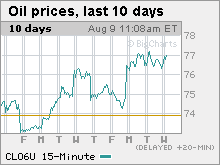|
Oil gains as stockpiles fall Crude oil, gasoline and distillates all show drawdown just as Alaska's North Slope output is halved. NEW YORK (CNNMoney.com) -- Oil prices, rallying earlier in the session, ended the day little changed despite a government report showing supplies of crude oil, gasoline and distillates falling more than expected. U.S. light crude for September delivery rose 4 cents to settle at $76.35 a barrel on the New York Mercantile Exchange. Crude rose as high as $77.40 following the report's release.
In its weekly inventory report, the Energy Information Administration said crude stocks fell by 1.1 million barrels. Analysts predicted a drop of 800,000 barrels, according to Reuters. Gasoline supplies slid by 3.2 million barrels while distillates, used to make heating oil and diesel fuel, fell by 200,000 barrels. Analysts had expected a decline of 1.1 million barrels in gasoline supplies and a 700,000 barrel build in distillates. "The market is very concerned," said Nauman Barakat, an energy trader at the Australian investment bank Macquarie, earlier in the day. "It's a lot bigger drawdown in gasoline than the market expected." While Wednesday's report covered last week and did not include effects from BP's Alaska shutdown over the weekend, it was being watched with particular attention as stockpiles are one source that are expected to cover the projected 400,000 barrel per day shortfall from the BP pipeline closure in Alaska. While some expect the disruption to be easily covered by existing petroleum stocks or ramped up output from other nations, fuel prices on the West Coast are expected to see the biggest impact. Most of Alaska's oil goes to refineries there and importing supplies from elsewhere will be more expensive. EIA said crude supplies on the West Coast stood at 53.8 million barrels, down 1.7 million barrels from the week prior. Gasoline supplies on the West Coast stood at 30.2 million barrels, also down 1.7 million barrels from tech week prior. Changes in these numbers on the West Coast will be closely watched over the next few weeks. Nationwide, EIA said crude stocks stood at 332.6 million barrels, which was well above average. Distillate stocks were also above average, although gasoline stocks were slightly below. But Barakat cautioned that replacing the lost Alaskan crude may be more difficult than people think. He said Saudi Arabian crude is the only real option in terms of a foreign supplier, and that will take 6 to 8 weeks to arrive. And borrowing stocks from the Strategic Petroleum Reserve for West Coast refining entails shipping the oil through the Panama Canal and perhaps paying it back at a higher price, as longer-dated contracts for crude are more expensive than the front month. "You'd be very reluctant to take a loan from the SPR," he said. 'It's not going to be cheap." Alaskan woes BP said Monday it was shutting down its Prudhoe Bay oilfield after tests showed pipelines carrying oil from storage tanks in the field to the larger Trans-Alaska pipeline had corroded by as much as 70 percent. Oil prices rallied 3 percent on that news Monday, but fell modestly Tuesday after BP said its working with regulators on ways to possibly keep about half the oil flowing from Prudhoe Bay as it fixes the problem. Replacing the 16 miles of pipeline could take months, and a full shut-in would take half of all Alaska's North Slope production, about 8 percent of the country's domestic oil output, offline. While 400,000 barrels per day is just 2 percent of the country's 20 million barrel a day oil habit, it still shook oil markets already on edge. Crude is currently hovering below its all-time record trading high of $78.40. It has gained around 25 percent since the start of the year and has nearly quadrupled in price since 2002, although it still remains below the inflation adjusted levels of around $90 a barrel set in early 1980 following the Arab oil embargo and Iranian Revolution. On the international front, Israel's Security Cabinet recommended Wednesday that the Israeli military expand its campaign against Hezbollah in southern Lebanon. While neither Israel or Lebanon produces much oil, the fear is that the weeks-old fighting could spread to the broader Middle East, which produces 30 percent of the world's oil and holds 60 percent of its reserves. In Nigeria, two Norwegians and two Ukrainians were kidnapped at gunpoint from an oil services ship off the coast Wednesday, Reuters reported. It's the latest in a series of abductions and violence in Africa's top oil producer as militants from the nation's impoverished but oil rich region fight for a bigger share of the country's oil wealth. And negotiations continue with Iran, the world's fifth largest oil producer, as the country tangles with the West over its nuclear program. While geopolitical tensions have always been a factor in oil prices, their effects have been magnified of late as surging demand has caused the world's spare production capacity to drop from more than 5 million barrels a day to around 1 million now. That means producer nations can't fill the gap if a supply disruption occurs in places like Iran or Nigeria. |
|



